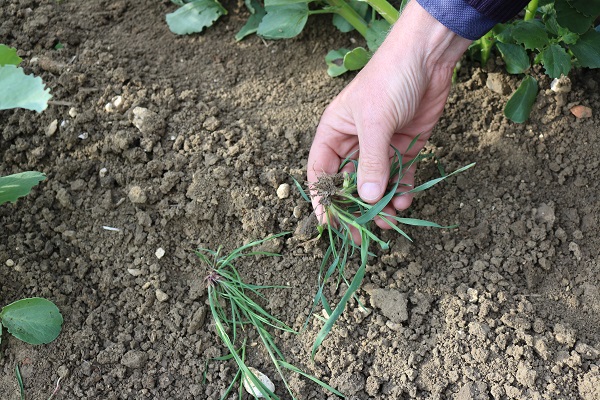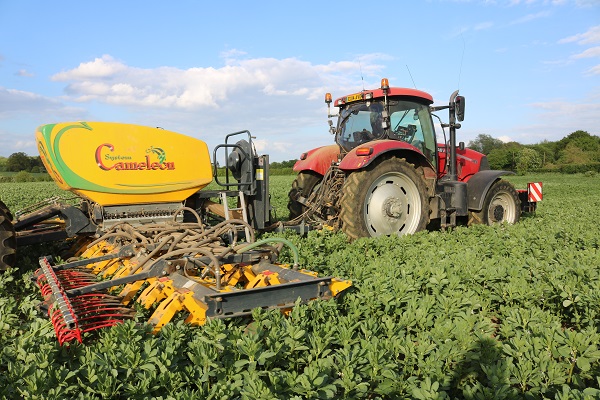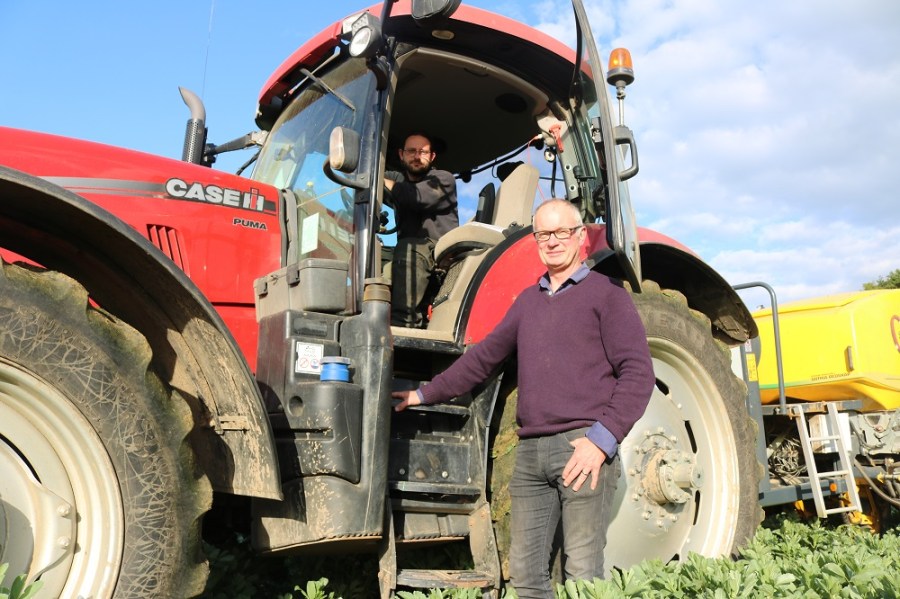Pea and bean crops must be grown without inputs if they’re to contribute to Ecological Focus Areas. CPM visits an organic arable farm in Suffolk to discover that doesn’t mean compromise and could have benefits if it’s taken across the entire rotation.
An organic farmer has to think out of the box. You’re not as constrained, but equally you have to be more creative and come up with your own solutions.
By Tom Allen-Stevens
John Pawsey stops for a moment as he strides through his bean crop and stoops down to inspect a severed blackgrass plant that’s been left on the surface between the 500mm wide rows.
“The hoe does a remarkably good job on the blackgrass – it cuts it off aggressively just below the surface, so it won’t grow back and won’t re-root,” he remarks.
Manufactured in Sweden, the 9m System Cameleon serves as both a seed drill and hoe. It’s a piece of kit that has enabled John to take the transition from “thinking like a conventional farmer to thinking like a true organic farmer”. At first, you’re not entirely sure whether he’s just saying that to come across as superior, but he explains:
“As a conventional farmer you have so many tools you can use, and you’re little more than an operator using them to keep your arable system simple. An organic farmer has to think out of the box. You’re not as constrained, but equally you have to be more creative and come up with your own solutions. Rather than keep things simple, the more diverse the better.”

The hoe cuts off the blackgrass just below the surface, so it won’t grow back and won’t re-root.
The winter bean crop is an absolutely integral part of the organic rotation John runs across the 1450ha he farms, half-owned and the rest farmed on contract, based at Shimpling Park Farm, near Bury St Edmunds, Suffolk. There’s a six-year rotation, two of which are fertility-building clover-rich leys. Following these come a mixture of ‘banker’ crops – the highest margin crops for which there’s a ready organic market – such as quinoa, spelt wheat and winter oats.
There are also spring oats and winter beans, with the latter in particular part of the rotation to maintain the fertility across the full six years. A spring wheat or spring barley, undersown with the grass/clover mix, completes the line-up. “We took the decision to convert to organic in 1999,” John recalls. “Wheat was languishing at £75/t. We wanted to keep farming, rather than get out or continue to diversify away from farming, but needed to add value.
“I was also slightly worried about the soils – for years we’d been paring back the fixed costs, and I didn’t think it was doing the system any long-term good. Something needed to change.”
It was a neighbouring farmer who inspired him into organic agriculture. “It’s not until you see a well run system in which all the crops really look great and the figures stack up that you realise it might be for you. The only difference was that he had livestock, and I had no intention of bringing animals in.”
He’s since relented, and the sheep flock, that grazes half of the leys, are “doing incredibly well”. But it’s been one of a number of learning curves for John. “Things came to a head in 2012. I was growing winter wheat, barley and beans with a one-year clover-ley fallow, that was undersown into the barley. Blackgrass had built up, the Warrior wheat broke down to yellow rust, the beans were devastated by chocolate spot and the barley barely yielded. I realised I was still thinking like a conventional farmer – growing crops at all costs and just focused on the gross margin.”

The System Cameleon is used to undersow the grass/clover leys as well as perform inter-row weeding and establish crops as a conventional drill.
He shifted his thinking to considering the rotation as a whole. “I’d been trying to keep things simple and that was a mistake. I realised I needed as much diversity in the system as possible.”
This brought to light the importance of the fertility-building elements of the rotation – previously regarded as fallow, the clover-rich leys became its powerhouse. “I realised how important it was to achieve a good establishment. The difficulty with undersowing into our Hanslope series clay here in Suffolk is that it sets like concrete. I’m spending £9000/year on small seeds. If that crop fails, it’s not only the cost of the seed that goes to waste – it has consequences for the next four years.”
It was social media that introduced John to the Cameleon system. A keen user of Twitter and YouTube, he regularly posts videos sharing his triumphs and failures and thrives on the feedback he receives. “Someone saw one of my videos and suggested I try the Cameleon. It’s a low disturbance drill with 36 coulters each individually mounted on a parallelogram with a press wheel, rather like a sugar beet drill. The difference is that it has a camera and also acts as a hoe.
“It sets the depth incredibly well, and has quite an aggressive action. So on the final hoe on the spring barley, we undersow the grass and clover, pressing it into the lightly disturbed soil which gives it just enough moisture.”
The system has also opened his eyes to new ways with winter beans. “The bean yield is all over the place – we average about 3.2t/ha, with the best at 5t/ha and the worst at 0.5t/ha. When all you get is 0.5t/ha, that makes a real dent in the cashflow. The biggest limiting factor is chocolate spot, so I aim to do everything we can to stop the disease taking hold.
“If you look at volunteer beans, they get chocolate spot, but they still pod up as if the disease isn’t really bothering them. So it’s the microclimate, created by the close canopy, that really allows the disease to develop, and what I’ve been working on reducing.”
The first step in the system is variety. “We grow a blend of three varieties – Arthur, Clipper and Wizard. The idea of the blend is to cover yourself for any varietal weaknesses. We home save and have the seed tested every year.
“We’ve also tried a crop of Honey. This variety is shorter than the other three which allows us to weedsurf.” This is a 12m topper, mounted on the three-point linkage with guide wheels on the wing tips. It’s taken above the crop late in the season to nip off weed heads, such as wild oats and charlock, that come above the crop.
“As for drilling date, I won’t drill before 20 Oct because the beans will get too winter proud. Chocolate spot before Christmas is a real worry,” continues John.
The beans are established with the Cameleon at a depth of just 75-100mm. “There is a balancing act here. We aim for a quick, even establishment and you need a decent plant stand to smother the weeds. But that’ll induce a microclimate for chocolate spot. So we’ve been working towards allowing a more open canopy.”
One option he’s tried is to bi-crop with winter oats. “We sowed the oats on 20 Sept at 500mm row spacings. Then we came in a month later and inter-row drilled the beans. The idea is that the oats act as a barrier to stop chocolate spot developing, and likewise the beans help protect as well as nurture the oats. You harvest both together and separate the grains with a cleaner.”
But the oats dominated. “It was the best crop of oats we’d ever had, but the bean yield was poor. What’s more, the following crop doesn’t look good, and we’ve had to bring in some digestate to compensate. I think there’s something that happens between oats and beans when you bi-crop them which means you lose the benefit of the beans as a rotational tool, and that’s vital in an organic system.”
So this year, there are no oats with the beans, but the 500mm rows have been kept. “I’m hoping this will encourage the crop to branch more – it’s why we choose winter over spring beans in the first place. Within the rows the plant density has kept on top of weeds, but there should be enough of an open canopy so that chocolate spot doesn’t take hold.”
It’s meant a minor modification on the Cameleon. The rows of beans are band sown to a width of about 60-70mm, at 500mm centres, which allows two hoe blades, offset at 250mm centres, to pass down between each row of crop. The blades themselves are alternately angled to aggressively disturb all the soil between each row, but leave the crop itself unscathed.
The more open canopy should encourage flowering and let the pollinators in, and John is hoping pod set will therefore also improve. One aspect it won’t help, though, is bruchid beetle. “There’s not much you can do about bruchid beetle in an organic crop, and it rarely makes the grade for human consumption as a result.”
The crop is highly valued as an organic feed source, however, and John sells his to British Quality Pigs, that are sold under the premium Duchy Original brand. The crop currently receives a healthy £320-380/t price.
As an organic crop, the only costs are weed control, but John cautions that it can be misleading to take any single organic crop and consider it outside the context of a rotation. “There are years in that rotation with no output, so you always have to consider it as a whole. What a straight gross margin also ignores is the benefit the beans bring to the rotation.”
Which raises the question of what conventional growers can learn from organic farming – what future is there for a fusion of organic with conventional, such as Conservation or Regenerative Agriculture? “Conservation Agriculture stole all our methods and made a system that’s more accessible,” says John with a wry smile.
“It’s true that organic farming has failed to capture farmers in quite the same way, but Conservation Agriculture still has its get outs, such as ammonium nitrate, triple super phosphate and glyphosate – you’re still in the mindset of the conventional farmer.
“That means you’re still just an operator within a system someone else is managing. You’ll spend an awful lot of time operating within a fungicide control programme, for example. I wouldn’t say I spend any less time obsessing about my crops and worrying about disease I know I can’t do anything about. But that encourages me to think in different ways, and that’s where the new ideas come from.”
There’s more than one way to get the EFA
Those planning to count pulse crops as their Ecological Focus Area may not apply agrochemicals to that crop, and the area must be multiplied by a factor of 0.7 to calculate the EFA contribution, according to current Basic Payment Scheme rules. But there may be better ways to use pulse crops to help towards the EFA, suggests PGRO’s Roger Vickers.
“I can’t believe that people would grow pulses simply to tick a box on a form – agronomically they have so much more to offer,” he notes.
“What John Pawsey’s system has shown is that it is a crop that can bring a decent return without the use of chemical inputs. There’s a lot a conventional grower can learn from an organic system for those prepared to put in the management attention. But it’s not a system you can simply dip in and out of, and John has had his disaster years. Most growers aim to minimise the use of agchems anyway, but at least like to have the option to use them.
“What is clear from John’s system, though, is the contribution his bean crop makes to building fertility and improving the soil across the rotation, and that’s something any grower can benefit from, whether or not you’re using agchems.”
He points out that pulse crops have a different growing window from other crops in the rotation, so can be used in conjunction with a catch or cover crop to contribute to the EFA.
“For example, a catch crop must be in place between Aug and Oct, so could be established after a cereal harvest, then the area planted with a conventional winter bean crop – that fits with the ideal time of year to establish a crop,” suggests Roger.
“Alternatively you could grow a conventional crop of peas after an EFA cover crop. They would be harvested in time to establish an EFA catch crop that could then be followed by a late-drilled winter wheat. That would deliver two years’ EFA requirement and bring in all the rotational benefits a pulse crop has to offer.”
Organic winter beans: how the finances stack up

Farm facts
Shimpling Park Farm, nr Bury St Edmunds, Suffolk
- Farmed area: 1450ha
- Cropping: Clover-rich grass leys; Winter wheat (some heritage varieties); spelt wheat; winter beans; winter oats; spring barley; spring oats; quinoa
- Livestock: 650-ewe NZ Romneys
- Soils: Hanslope series clay loam
- Mainline tractors: Case IH Quadtrac 450; Puma 185; John Deere 6170R
- Combines: Claas Lexion 750 TT with 9m header
- Seeder/hoe: 9m System Cameleon with up to 36 coulters/blades
- Weeding: 2x 8.8 CTM Weedsurfer; 9m Einbӧck tine weeder
- Loader: JCB 530/70
- Ploughs: 2x 6f Dowdeswell
- Cultivation: 5m Gregoire Besson Discordon; 9m Väderstad Carrier; 9m Dalbo Cultimax
- Staff: Two full time plus John plus seasonal workers and weed-roguing team




